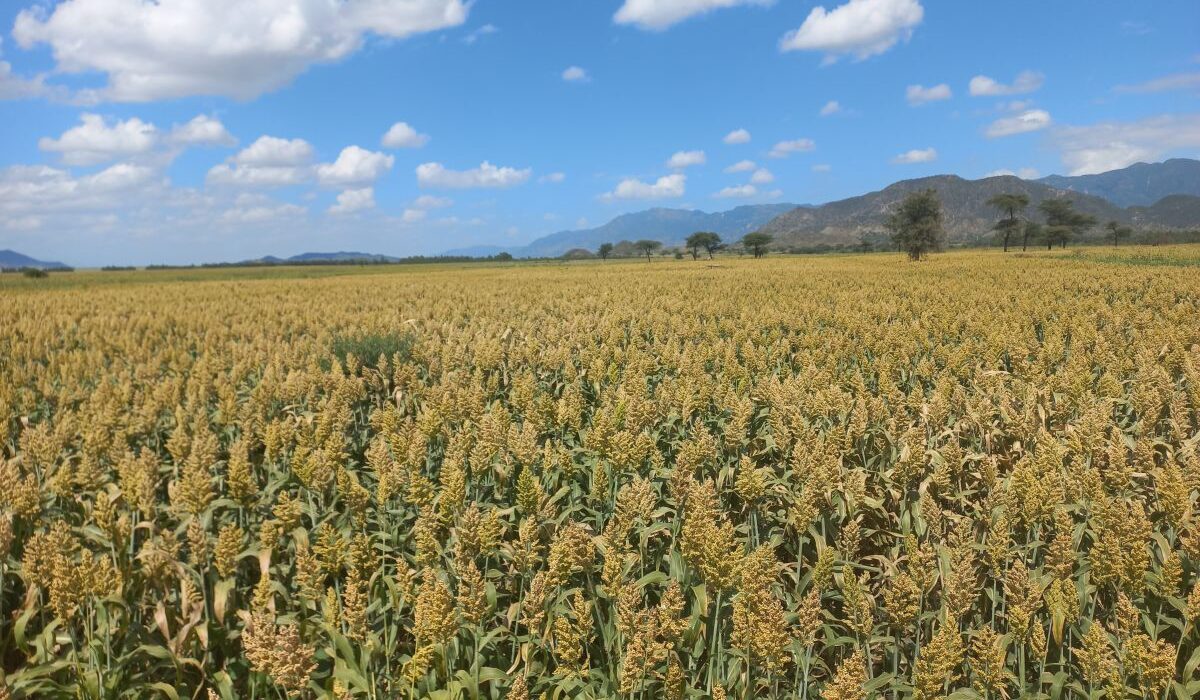Sorghum farming in Kenya has gained attention as a viable and sustainable agricultural practice. As a drought-resistant crop, sorghum thrives in the country’s dry areas, making it an excellent choice for farmers in regions with limited rainfall. Sorghum’s versatility in both food and industrial applications, coupled with its strong market demand, presents a promising opportunity for Kenyan farmers to increase their income while contributing to the country’s food security.
In this article, we’ll explore everything you need to know about sorghum farming in Kenya, from its nutritional benefits to how to grow it effectively, and where to sell it. This comprehensive guide is packed with valuable information and actionable insights that Kenyan farmers and agribusiness professionals can use to start or expand their sorghum farming ventures.
What is Sorghum Farming?
Sorghum is a cereal grain widely grown in Kenya for its seeds, which are used in food products, animal feed, and industrial processes. It belongs to the grass family and has long been a staple food crop in many parts of Africa, including Kenya. It can be grown for human consumption in the form of flour or used for brewing and other commercial applications.
In Kenya, sorghum is primarily cultivated in regions such as Central Kenya, Western Kenya, the North Rift, and Eastern Kenya. These regions have dry, semi-arid climates where the crop thrives, making it an ideal choice for farmers looking to diversify their agricultural activities.
Why Sorghum Farming?
- Drought Resistance: Sorghum is known for its ability to thrive in dry conditions. It requires less water compared to other crops, making it ideal for Kenya’s arid and semi-arid regions.
- Versatility: Sorghum can be grown for its seeds or used as fodder for livestock. It’s also used to make various products such as flour, beer, and even biofuels.
- Nutritional Value: Sorghum is rich in fiber, minerals, and vitamins, making it an essential component of a balanced diet.
Varieties of Sorghum Grown in Kenya
There are several varieties of sorghum cultivated across Kenya, each with unique characteristics suited to different growing conditions. Below are some of the most commonly grown varieties:
- Seredo: A high-yielding variety known for its resistance to drought and pests.
- Mtama 1: A popular variety among farmers due to its high resistance to diseases and pests.
- Mtama 2: Another variety resistant to pests and known for its early maturity.
- Gadam: A high-yielding variety that grows well in low rainfall areas.
- Serena: Known for its excellent milling quality, making it ideal for flour production.
- E6518: A hybrid variety that thrives in dry regions and is known for its high grain yield.
- IS76: A variety resistant to smut disease and capable of producing high-quality grain.
- BJ28: Known for its drought tolerance and suitability for low-fertility soils.
- E1291: A variety with high disease resistance, suitable for both food and fodder production.
Nutritional Benefits of Sorghum
Sorghum is not only a versatile crop but also offers numerous health benefits. Here’s why including sorghum in your diet is beneficial:
- Rich in Fiber: Sorghum is an excellent source of dietary fiber, which aids in digestion and helps maintain a healthy gut.
- High in Minerals: It contains essential minerals such as magnesium, which is vital for bone formation and energy production.
- Packed with Vitamins: Sorghum is a rich source of Vitamin B, which supports metabolism and overall health.
- Gluten-Free: Sorghum is naturally gluten-free, making it an ideal grain for people with gluten intolerance or celiac disease.
- Antioxidant Properties: Sorghum contains antioxidants, which can help reduce inflammation and protect against oxidative stress.
Ideal Ecological Conditions for Growing Sorghum
Sorghum can be grown in a variety of climatic conditions, but it performs best under specific ecological conditions. Here’s what you need to know:
1. Soil Type
Sorghum prefers well-drained, fertile soils. It thrives in sandy loam soils with a pH range of 5.5 to 7.0. Avoid planting in heavy clay soils, which can lead to waterlogging and poor root development.
2. Temperature
Sorghum grows best in regions with temperatures between 15°C and 35°C. It can tolerate higher temperatures, which is why it is popular in Kenya’s dry areas.
3. Rainfall
Sorghum requires annual rainfall ranging from 400mm to 650mm. In areas with less rainfall, farmers can irrigate their crops to supplement water supply.
4. Altitude
Sorghum grows well in areas with altitudes below 1500m. It can tolerate both lowland and mid-altitude regions, which makes it ideal for various parts of Kenya.
How to Plant Sorghum in Kenya
1. Preparation
Before planting, prepare the land by clearing weeds, rocks, and other debris. Ensure the soil is properly tilled to allow for good seed-to-soil contact.
2. Seed Selection
Choose high-quality seeds from reputable suppliers. Opt for certified seeds to ensure good germination and disease resistance.
3. Planting Method
Sorghum is propagated by seed, and it is typically sown in rows. The recommended row spacing is between 45cm to 60cm, and seeds should be sown 2-3 cm deep. Sorghum plants are usually spaced 20-30cm apart.
4. Fertilization
Sorghum requires sufficient nutrients for optimal growth. Apply fertilizers like DAP (Diammonium Phosphate) during planting to encourage strong root development. During the growing season, use CAN (Calcium Ammonium Nitrate) or NPK fertilizers to promote healthy plant growth.
5. Intercropping
Intercropping sorghum with legumes such as cowpeas, beans, or groundnuts can help improve soil fertility and increase overall yield.
Sorghum Weeding and Pest Control
Weeding is an essential part of sorghum farming. Weeds can compete with sorghum for nutrients, water, and sunlight. Use appropriate herbicides to control weeds, especially during the early stages of growth.
Pests like aphids, grasshoppers, and birds can damage sorghum crops. Employ integrated pest management (IPM) strategies such as using resistant varieties, biological control agents, and chemical pesticides when necessary.
Harvesting Sorghum
Sorghum typically matures between 3 to 4 months, depending on the variety and environmental conditions. However, some varieties may take longer to mature.
Harvesting Tips:
- Harvest when the seed heads are fully mature and dry. The seeds should be hard and not easy to crush.
- Use a sickle or knife to cut the heads from the plant.
- If necessary, thresh the grains to remove them from the stalks.
The Sorghum Market in Kenya
There is a growing demand for sorghum both locally and internationally. In Kenya, sorghum is used in a variety of industries, from food production to brewing. Below are some key buyers of sorghum in Kenya:
- East African Breweries Limited (EABL): EABL uses sorghum in the production of alcoholic beverages like beer.
- Unga Limited: A major player in the food processing industry, Unga Limited purchases sorghum for milling and flour production.
- Kenya Industrial Research and Development Institute (KIRDI): KIRDI supports the use of sorghum in research and development projects.
Farmers can also sell their sorghum to NGOs, schools, and local markets, where there is demand for affordable, nutritious food options.
Market Prices
The price of sorghum fluctuates depending on factors like supply, demand, and the quality of the crop. On average, a 90 kg bag of sorghum in Kenya costs between Ksh 3,500 and Ksh 5,000.
Challenges and Solutions in Sorghum Farming
While sorghum farming in Kenya offers numerous benefits, there are some challenges that farmers must overcome:
- Pest and Disease Management: Sorghum is susceptible to pests and diseases like grain molds and smut. Integrated pest management practices can help mitigate these issues.
- Market Access: Small-scale farmers may face challenges in accessing reliable markets. Cooperatives and farmer groups can help address this by creating collective selling opportunities.
Is Sorghum Farming a Lucrative Venture?
Sorghum farming in Kenya presents a promising opportunity for farmers looking to diversify their crops and tap into both local and international markets. With its drought resistance, nutritional benefits, and strong market demand, sorghum can provide significant financial returns for Kenyan farmers.
If you’re considering starting a sorghum farming venture, ensure you carefully plan your planting schedule, invest in quality seeds, and manage your crops effectively to maximize yields. With the right strategies, sorghum farming can become a profitable and sustainable business for Kenyan farmers.
Are you ready to start your sorghum farming journey? Join a local agricultural cooperative, invest in the right seeds, and get access to expert farming resources today! Reach out to sorghum farming networks and local extension officers to get started.





